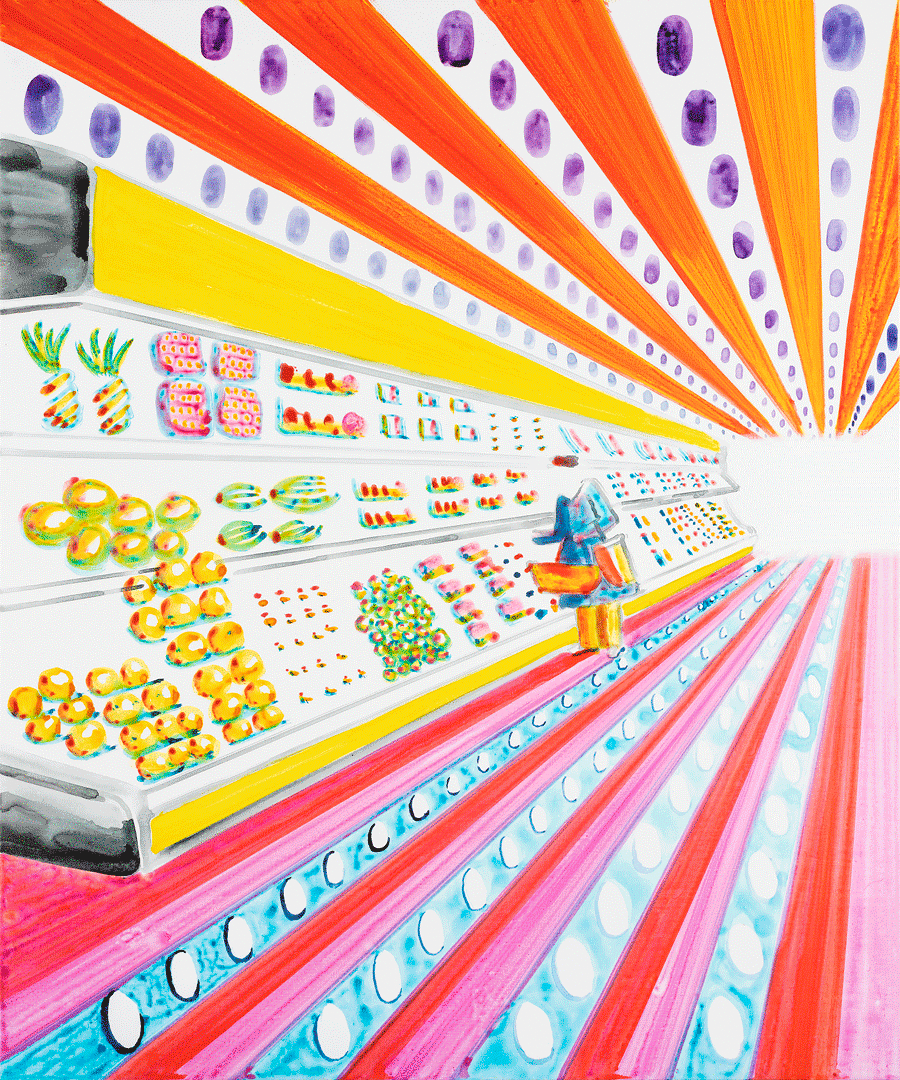Crazy Watermelon Shipping
August 21–October 3, 2020
Flaesketorvet 85A
1711 Copenhagen
Denmark
Hours: Tuesday–Friday 1–6pm,
Saturday 11am–4pm
T +45 33 93 42 21
bjerggaard@bjerggaard.com
Galleri Bo Bjerggaard is proud to present the exhibition Crazy Watermelon Shipping—Danish artist John Kørner’s third solo show in the gallery in Copenhagen.
Thematically, the point of departure for the show is the global market and consumption patterns, and the exhibition is based on supermarket aesthetics.
Fanny Lundgren, MA in Art History and John Kørner’s Studio Manager writes:
Picture yourself on the very tip of Jutland, on Grenen, a sand spit with a view of a nebulous parking zone for container ships and cruise liners carrying everything from giant, orange gas cylinders to tourists, food and many other things for the potential benefit of us on the shore looking out. A strategic spot for parking ships, the sea of Kattegat offers easy access to the whole world.
This is a key point of departure for John Kørner’s (b. 1967) Crazy Watermelon Shipping. Revolving around issues of consumption and goods in transit, the exhibition examines the global market and how we experience it in everyday life, say at the supermarket when we debate what items to place in our baskets. Some people have only one option when it comes to shopping, others have a few more, while others again have nothing but shopping options.
Kørner, who lives in Nørrebro, Copenhagen, belongs to the last group. He has options galore: greengrocers and specialty shops running the gamut from caramel maker to Polish takeaways, on top of the regular supermarkets. As the artist puts it, each contains a whole world. “They are all super international. There are oranges from Spain, bananas from South America and olives from Greece. At some point in time, these commodities were in that country. There is an exotic atmosphere, which is fascinating—you get a small taste of another country.”
Not only the packaging or the merchandise itself provide an illusion of origin, provenance and the culture of the country where the watermelon is from. The goods are wrapped in a rhetoric and a visual style designed to seduce and fascinate us as consumers. The story is usually one of “authenticity and romance.” The powerful sensory experience of shopping at a supermarket or greengrocer also has a dark side of labour exploitation and depletion of natural resources. Still, we should separate our experience of the goods from the means of their production. Our joy and love of the gaudy perfection of fruits cannot be taken away. It persists, tickling our fancy and drawing us to boxes of red-green apples, yellow bananas and oranges. The sensation is one of immediate beauty.
It is an absurd privilege to sink your teeth into a “crazy watermelon.” There is something both fantastic and hugely problematic about this commodity, which has been shipped from another country, another culture, without us giving it a second thought at the moment of purchase. Of course we are aware of the environmental and human costs of this privilege. The watermelon has to be shipped from A to B, or from A to B to C to D, in a container ship, truck or plane, and loads of produce is thrown out when it goes past the expiration date. We have not had to suffer without this privilege even during the Covid-19 crisis, reflecting how commanding the global market and our consumption patterns are. That is why the ships are parked in the Kattegat. They are awaiting orders about where to deliver their cargo to enable the continued excitation of our senses in the supermarket.
For centuries, shipping has been the primary means of trading goods. As the artist says, “The system is intact and has grown dramatically.” In Kørner’s exhibition, especially the paintings, we witness a reflection of our trips to the greengrocer or supermarket. Our senses, above all are eyes, are bombarded by alluring and powerful colours, providing an immediate sensation of enjoyment and fascination. But here, too, there is a flipside. We also see the container ships and the global market. We see the woman in front of a frozen food case with an abnormal female body on top. We see a river running through a stringent shelving system stocked with produce.




